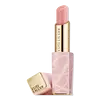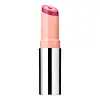Estée Lauder Pure Color Envy Color Replenish Lip Balm Versus Clinique Moisture Surge Pop Triple Lip Balm
What's inside
What's inside
 Key Ingredients
Key Ingredients

 Benefits
Benefits

 Concerns
Concerns

 Ingredients Side-by-side
Ingredients Side-by-side

Ricinus Communis Seed Oil
MaskingGlyceryl Triacetyl Ricinoleate
EmollientCetyl Ricinoleate
EmollientEuphorbia Cerifera Wax
Bis-Diglyceryl Polyacyladipate-2
EmollientCopernicia Cerifera Wax
Polyethylene
AbrasiveEthylhexyl Palmitate
EmollientTriticum Vulgare Bran Extract
Skin ConditioningOlea Europaea Fruit Extract
BleachingPalmitoyl Tripeptide-1
Skin ConditioningButylene Glycol
HumectantCholesterol
EmollientGlyceryl Stearate
EmollientTribehenin
EmollientLauryl Methacrylate/Glycol Dimethacrylate Crosspolymer
Sodium Hyaluronate
HumectantPotassium Sulfate
Oleic Acid
EmollientSilica Dimethyl Silylate
EmollientPalmitic Acid
EmollientTocopheryl Acetate
AntioxidantVanillin
MaskingPentaerythrityl Tetra-Di-T-Butyl Hydroxyhydrocinnamate
AntioxidantSorbitan Isostearate
EmulsifyingAroma
Mica
Cosmetic ColorantCI 77891
Cosmetic ColorantCI 45380
Cosmetic ColorantCI 17200
Cosmetic ColorantCI 75470
Cosmetic ColorantRicinus Communis Seed Oil, Glyceryl Triacetyl Ricinoleate, Cetyl Ricinoleate, Euphorbia Cerifera Wax, Bis-Diglyceryl Polyacyladipate-2, Copernicia Cerifera Wax, Polyethylene, Ethylhexyl Palmitate, Triticum Vulgare Bran Extract, Olea Europaea Fruit Extract, Palmitoyl Tripeptide-1, Butylene Glycol, Cholesterol, Glyceryl Stearate, Tribehenin, Lauryl Methacrylate/Glycol Dimethacrylate Crosspolymer, Sodium Hyaluronate, Potassium Sulfate, Oleic Acid, Silica Dimethyl Silylate, Palmitic Acid, Tocopheryl Acetate, Vanillin, Pentaerythrityl Tetra-Di-T-Butyl Hydroxyhydrocinnamate, Sorbitan Isostearate, Aroma, Mica, CI 77891, CI 45380, CI 17200, CI 75470
Octyldodecanol
EmollientSynthetic Fluorphlogopite
Pentaerythrityl Adipate/Caprate/Caprylate/Heptanoate
EmollientPetrolatum
EmollientBis-Diglyceryl Polyacyladipate-2
EmollientPolyethylene
AbrasiveHydrogenated Dilinoleyl Alcohol
EmollientStearoxymethicone/Dimethicone Copolymer
EmollientSilica
AbrasivePolybutene
Microcrystalline Wax
Emulsion StabilisingEthylhexyl Palmitate
EmollientCalcium Sodium Borosilicate
Sodium Hyaluronate
HumectantButyrospermum Parkii Butter
Skin ConditioningPolyglyceryl-4 Isostearate
EmulsifyingLauryl PCA
HumectantAloe Barbadensis Leaf Extract
EmollientCocos Nucifera Oil
MaskingOlea Europaea Fruit Extract
BleachingPalmitoyl Tetrapeptide-7
Skin ConditioningPalmitoyl Tripeptide-1
Skin ConditioningCetyl PEG/PPG-10/1 Dimethicone
EmulsifyingTocopheryl Acetate
AntioxidantCholesterol
EmollientGlycerin
HumectantGlyceryl Stearate
EmollientCaprylyl Glycol
EmollientLinoleic Acid
CleansingC20-40 Pareth-10
EmulsifyingButylene Glycol
HumectantWater
Skin ConditioningHydroxyethylcellulose
Emulsion StabilisingEthylcellulose
Methyl Glucose Sesquistearate
EmollientTriticum Vulgare Bran Extract
Skin ConditioningHexylene Glycol
EmulsifyingTriethoxycaprylylsilane
Palmitic Acid
EmollientOleic Acid
EmollientSilica Dimethyl Silylate
EmollientTin Oxide
AbrasivePotassium Sulfate
Hexyl Laurate
EmollientCalcium Aluminum Borosilicate
Alumina
AbrasiveCarbomer
Emulsion StabilisingPolysorbate 20
EmulsifyingLauryl Methacrylate/Glycol Dimethacrylate Crosspolymer
Phenoxyethanol
PreservativeMica
Cosmetic ColorantCI 77891
Cosmetic ColorantCI 77491
Cosmetic ColorantCI 77492
Cosmetic ColorantCI 77499
Cosmetic ColorantCI 15850
Cosmetic ColorantCI 45410
Cosmetic ColorantCI 42090
Cosmetic ColorantCI 17200
Cosmetic ColorantCI 19140
Cosmetic ColorantCI 77742
Cosmetic ColorantCI 45380
Cosmetic ColorantCI 73360
Cosmetic ColorantCI 75470
Cosmetic ColorantCI 77163
Cosmetic ColorantCI 15985
Cosmetic ColorantCI 45370
Cosmetic ColorantOctyldodecanol, Synthetic Fluorphlogopite, Pentaerythrityl Adipate/Caprate/Caprylate/Heptanoate, Petrolatum, Bis-Diglyceryl Polyacyladipate-2, Polyethylene, Hydrogenated Dilinoleyl Alcohol, Stearoxymethicone/Dimethicone Copolymer, Silica, Polybutene, Microcrystalline Wax, Ethylhexyl Palmitate, Calcium Sodium Borosilicate, Sodium Hyaluronate, Butyrospermum Parkii Butter, Polyglyceryl-4 Isostearate, Lauryl PCA, Aloe Barbadensis Leaf Extract, Cocos Nucifera Oil, Olea Europaea Fruit Extract, Palmitoyl Tetrapeptide-7, Palmitoyl Tripeptide-1, Cetyl PEG/PPG-10/1 Dimethicone, Tocopheryl Acetate, Cholesterol, Glycerin, Glyceryl Stearate, Caprylyl Glycol, Linoleic Acid, C20-40 Pareth-10, Butylene Glycol, Water, Hydroxyethylcellulose, Ethylcellulose, Methyl Glucose Sesquistearate, Triticum Vulgare Bran Extract, Hexylene Glycol, Triethoxycaprylylsilane, Palmitic Acid, Oleic Acid, Silica Dimethyl Silylate, Tin Oxide, Potassium Sulfate, Hexyl Laurate, Calcium Aluminum Borosilicate, Alumina, Carbomer, Polysorbate 20, Lauryl Methacrylate/Glycol Dimethacrylate Crosspolymer, Phenoxyethanol, Mica, CI 77891, CI 77491, CI 77492, CI 77499, CI 15850, CI 45410, CI 42090, CI 17200, CI 19140, CI 77742, CI 45380, CI 73360, CI 75470, CI 77163, CI 15985, CI 45370
Ingredients Explained
These ingredients are found in both products.
Ingredients higher up in an ingredient list are typically present in a larger amount.
This ingredient is lipid-based synthetic skin-conditioning agent derived from adipic acid and a mixture of fatty acids. It is often called a lanolin substitute.
As an emollient, it helps soften and hydrate the skin. Emollients create a barrier on the skin to trap moisture in.
Due to its fatty acid base, it may not be Malassezia folliculitis safe.
Learn more about Bis-Diglyceryl Polyacyladipate-2Butylene Glycol (or BG) is used within cosmetic products for a few different reasons:
Overall, Butylene Glycol is a safe and well-rounded ingredient that works well with other ingredients.
Though this ingredient works well with most skin types, some people with sensitive skin may experience a reaction such as allergic rashes, closed comedones, or itchiness.
Learn more about Butylene GlycolCholesterol is a class of organic molecules called lipids. It helps hydrate your skin and is essential to having a healthy skin barrier.
Our skin naturally contains cholesterol in the outermost layer. Besides cholesterol, it also contains ceramides and fatty acids. Cholesterol makes up about 1/4 of your skin's outer layer and barrier. Your skin barrier is responsible for keeping allergens and microbes out. Having a healthy skin barrier is also responsible for keeping your skin firm and plump.
Our bodies use cholestrol to create vitamin D, steroid hormones, and more.
Learn more about CholesterolCi 17200 is a synthetic reddish-purple dye.
Ci 45380 is a synthetic dye that comes from coal or tar sources. Due to this, it is often used in small quantities.
A common name for this dye is Red 22. Red 22 imparts a warm reddish color.
Similar to Red 27, this dye changes color based on pH and moisture levels.
This dye is colorless when dry but turns pink between pH levels 0.0 to ~3.0.
Learn more about CI 45380Ci 75470 is a bright-red pigment. It is AKA carmine.
Carmine is derived from insects such as the cochineal beetle. This ingredient has been used as a natural dye for over 2000 years.
Ci 77891 is a white pigment from Titanium dioxide. It is naturally found in minerals such as rutile and ilmenite.
It's main function is to add a white color to cosmetics. It can also be mixed with other colors to create different shades.
Ci 77891 is commonly found in sunscreens due to its ability to block UV rays.
Learn more about CI 77891Ethylhexyl Palmitate, also known as octyl palmitate, is created from 2-ethylhexyl alcohol and palmitic acid. It is a fatty acid ester.
The fatty acid content of Ethylhexyl Palmitate makes it an emollient. Emollients help soften and hydrate your skin by trapping moisture within.
Ethylhexyl Palmitate is also used to help improve the texture of cosmetics. It helps other ingredient dissolve in products and help disperse ingredients more evenly.
You'll likely find this ingredient in sunscreen, as it is often used to mix UV-blocking ingredients such as avobenzone and ethylhexyl triazone.
It can also help stabilize the fragrances in a product as a fragrance fixative.
Ethylhexyl Palmitate can be used to substitute mineral oil.
Due to its high fatty acid content, it may not be fungal-acne safe.
Learn more about Ethylhexyl PalmitateGlyceryl Stearate is a mix of glycerin and stearic acid.
It is used to stabilize the mixing of water and oil ingredients. By preventing these ingredients from separating, it can help elongate shelf life. It can also help thicken the product's texture.
As an emollient, it helps soften skin and supports barrier-replenishing ingredients.
In cosmetics, Glyceryl Stearate is often made from vegetable oils or synthetically produced.
This ingredient may not be fungal-acne safe
Fun fact: The human body also creates Glyceryl Stearate naturally.
Learn more about Glyceryl StearateWe don't have a description for Lauryl Methacrylate/Glycol Dimethacrylate Crosspolymer yet.
Mica is a naturally occurring mineral used to add shimmer and color in cosmetics. It can also help improve the texture of a product or give it an opaque, white/silver color.
Serecite is the name for very fine but ragged grains of mica.
This ingredient is often coated with metal oxides like titanium dioxide. Trace amounts of heavy metals may be found in mica, but these metals are not harmful in our personal products.
Mica has been used since prehistoric times throughout the world. Ancient Egyptian, Indian, Greek, Roman, Aztec, and Chinese civilizations have used mica.
Learn more about MicaOlea Europaea Fruit Extract is extract from the olive fruit. Olive fruit contains hydrating ingredients such as squalene and fatty acids.
It contains the fatty acids linoleic acid, oleic and palmitic acid.
Due to this fatty acid content, this ingredient may not be fungal-acne safe.
Learn more about Olea Europaea Fruit ExtractOleic Acid is an Omega-9 fatty acid. It can be found in many plant oils such as avocado and marula oils.
This ingredient is used to enhance the texture of products and as a cleansing agent.
Oleic Acid may not be fungal acne safe.
Learn more about Oleic AcidPalmitic Acid is a fatty acid naturally found in our skin and in many plant and animal sources. In cosmetics, it is usually derived from palm oil. It serves many purposes in skincare, acting as a cleanser, emollient, and emulsifier.
As an emollient, palmitic acid helps soften and smooth the skin by preventing water loss. In cleansers, it helps remove oil and dirt while creating foam.
Its emulsifying properties help stabilize products by keeping water and oil-based ingredients from separating.
This may not be suitable for fungal acne-prone skin, as fatty acids like this can sometimes trigger breakouts in sensitive individuals.
Learn more about Palmitic AcidPalmitoyl Tripeptide-1 is also known as pal-GHK. It is made up of 3 amino acids and palmitic acid, a fatty acid that helps it absorb into skin more easily.
This peptide is as a signal peptide, meaning it tells the skin to produce more collagen. Collagen is the key protein that helps form the skin's structure and keep it plump, firm, and hydrated.
By boosting collagen production, this ingredient supports a stronger skin barrier and helps reduce the appearance of wrinkles.
You'll most likely see this ingredient paired with Palmitoyl Tetrapeptide-7 in the well-known Matrixyl 3000 complex. While results from in-house testing should be viewed cautiously, this peptide duo is among the most studied and widely used in modern skincare.
Due to its palmitic acid base, this ingredient may not be safe for Malassezia folliculitis.
Read more about other common types of peptides here:
Learn more about Palmitoyl Tripeptide-1Polyethylene is a synthetic ingredient that helps the skin retain moisture. It is a polymer.
It is also typically used within product formulations to help bind solid ingredients together and thicken oil-based ingredients. When added to balms and emulsions, it helps increase the melting point temperature.
Potassium Sulfate is a type of sulfate.
This silica is mainly used to thicken oils and suspend particles in oils. It is not water soluble.
According to the manufacturer, it:
The manufacturer also claims this ingredient to be useful in makeup.
In lipstick formulations, this ingredient improves color payoff, reduces pigment settling, and reduces oil bleeding. This ingredient also improves the grip of powder products such as dry shampoos.
Learn more about Silica Dimethyl SilylateSodium Hyaluronate is hyaluronic acid's salt form. It is commonly derived from the sodium salt of hyaluronic acid.
Like hyaluronic acid, it is great at holding water and acts as a humectant. This makes it a great skin hydrating ingredient.
Sodium Hyaluronate is naturally occurring in our bodies and is mostly found in eye fluid and joints.
These are some other common types of Hyaluronic Acid:
Learn more about Sodium HyaluronateTocopheryl Acetate is AKA Vitamin E. It is an antioxidant and protects your skin from free radicals. Free radicals damage the skin by breaking down collagen.
One study found using Tocopheryl Acetate with Vitamin C decreased the number of sunburned cells.
Tocopheryl Acetate is commonly found in both skincare and dietary supplements.
Learn more about Tocopheryl AcetateWe don't have a description for Triticum Vulgare Bran Extract yet.